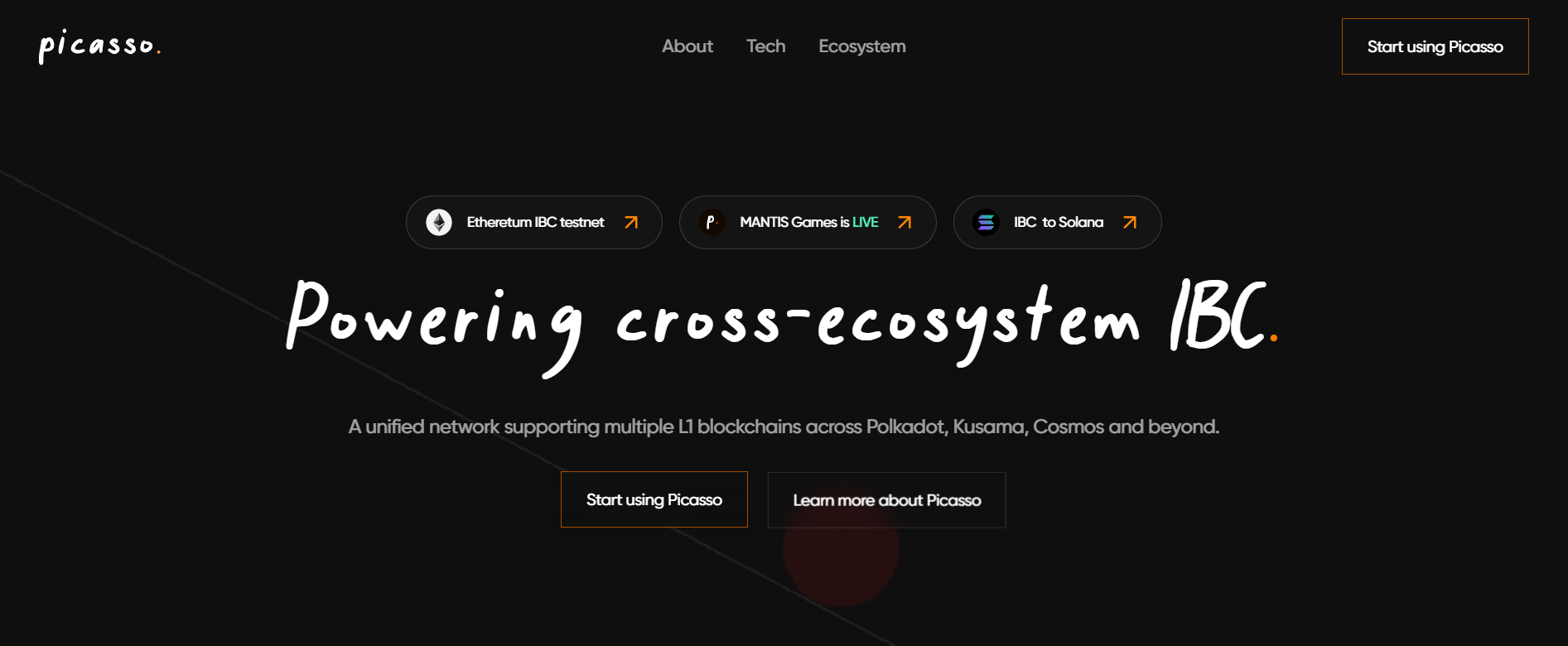Picasso represents an infrastructure layer that leads the development of interoperable solutions for decentralized finance (DeFi). It is built on the Kusama network and thus forms part of the broader DotSama ecosystem. Picasso boasts a high level of security, efficiency, and inherent interoperability, thanks to the use of a parachain and its proprietary technology stack.

Overview of Picasso
The Picasso project incorporates revolutionary foundational elements in the field of decentralized finance DeFi primitives built as modular pallets. These pallets are designed to attract liquidity from the broader landscape of decentralized finance, while facilitating interaction between various ecosystems. Thus, thanks to its interoperability, Picasso strives to become an ecosystem filled with liquidity from various blockchain networks. Developers interested in the interoperability framework of Picasso will find the core pallets and SDKs useful as they stimulate the development process for working on Picasso.
With the ability of Picasso to integrate with other parachains and blockchains supporting IBC, new possibilities open up for creating strategies that use the best solutions from Substrate and Cosmos SDK blockchains. This has been made possible thanks to key innovations by the bridging team.
As the first instance of CosmWasm being used outside the Cosmos ecosystem, existing projects can deploy a satellite protocol on Picasso and gain access to a completely new ecosystem of users and developers.
Governance and Security of Picasso
As a parachain connected to the Kusama network, Picasso benefits from the "shared security model" of this network.
Governance mechanisms for the platform are intended to ensure the growth and adaptation of the ecosystem in line with the desires and needs of the Picasso community. Therefore, all token holders have the opportunity to participate in governance, with their votes weighted according to their stake. Moreover, any changes to Picasso must be approved through a referendum, in which the decisive word belongs to the holders of PICA tokens.
The fundamental principles guiding participation in the open governance system of Picasso include the following:
- Support for token holder participants who have an impact on Picasso, even if their opinions and desires differ from the position of the Composable team
- Prioritizing the interests of Picasso and its community over the personal interests of participants
- Maintaining transparency and openness to the public
- Responsible behavior with an awareness of the consequences of one's actions or inaction
- Active fight against any forms of malicious communication, behavior, and activity
The cross-chain token PICA supports the operation of multiple networks. Additional value will accrue to the token depending on the success of cross-interaction IBC efforts. PICA is the primary token of Picasso and Composable Cosmos.
Efforts have been made to ensure the maximum utility of the PICA token, including various methods of value accumulation and governance features. The PICA token provides rewards for participating in the ecosystem, but is also fundamental to the operation of aggregators, validators, oracles, and other cross-ecosystem strategies.
Uses of $PICA:
| Type of Staking | Description |
|---|---|
| Aggregator Staking on Picasso | Aggregators on Picasso are required to stake for block production in our parachain, as is the case in most proof of stake networks. |
| Apollo Staking | Apollo is a permitted oracle, resistant to MEV. Anyone can run an oracle on Picasso by providing a stake in PICA. |
| Validator Staking | PICA is used to secure the Composable Cosmos network. This is the first instance of a token being used for validation in both the Kusama and Cosmos ecosystems. |
| Liquid Staking Revenue (coming soon) | Staking with liquid assets on the Polkadot base. |
| Bridging Revenue (coming soon) | A percentage of the bridge fees generated by each new IBC connection involving Picasso will be distributed among PICA stakers on Composable Cosmos. |
| Tri-level Token Staking Model | In the Picasso ecosystem, there are several ways of staking to earn income in PICA. This model strengthens network security, maintaining liquidity, and redistributing maximum value back to Picasso token holders. |
Insights into the Platform's Pallets
Blockchain developers using Substrate can quickly create autonomous Layer 1 blockchains using core building blocks called pallets. These pallets, similar to Cosmos SDK modules, can be combined in various ways to create a customized runtime environment. Substrate offers developers the option to either use existing pallets or develop new ones to introduce additional functionalities as needed.
Picasso offers a wide range of Substrate pallets that synergistically form a powerful platform for interoperable DeFi solutions. By reducing transaction costs, creating modular applications for adaptive liquidity movement, and implementing innovative solutions, Picasso effectively addresses key challenges in the realm of interactions in DeFi. These challenges include liquidity fragmentation, asset transfer security, and the lack of standardized cross-chain communication protocols. Within the Picasso ecosystem, DeFi essentials such as Composable-IBC and Pablo demonstrate their effectiveness.







